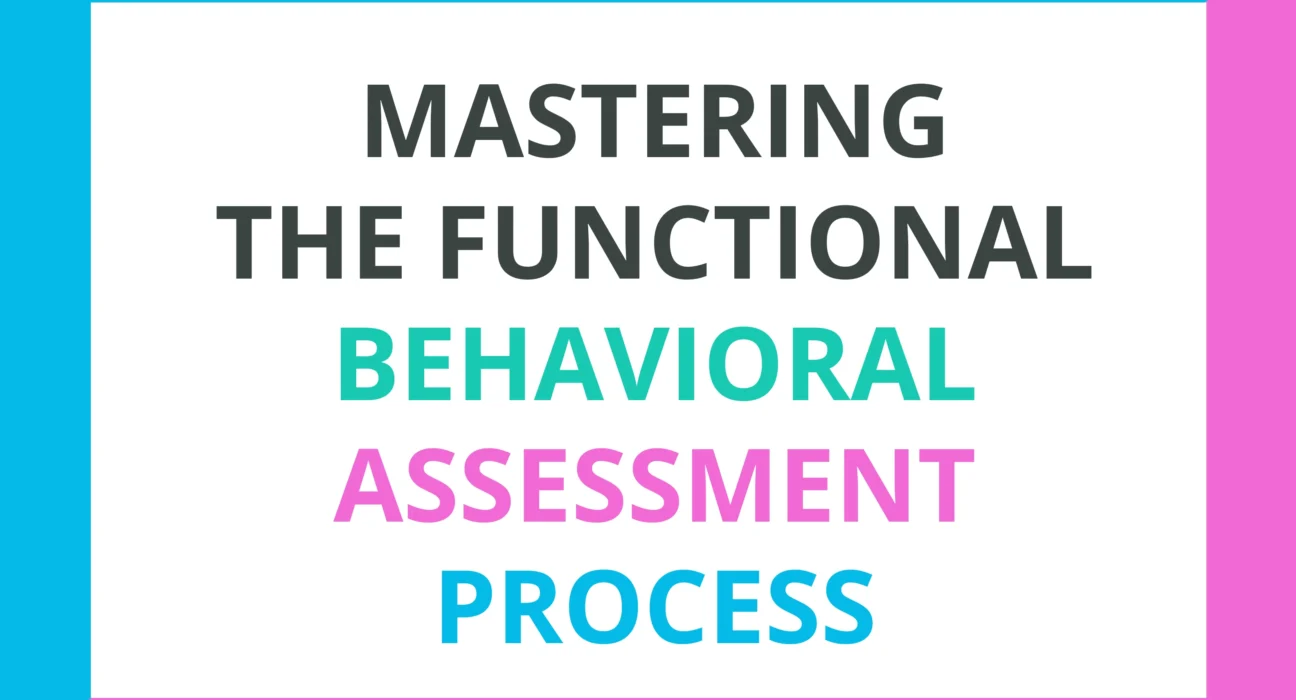Introduction to the Functional Behavioral Assessment Process
The Functional Behavioral Assessment (FBA) process is a structured method used to analyze and understand problematic behaviors by identifying their underlying causes. Unlike traditional approaches that may focus solely on the behavior itself, FBA seeks to understand why a behavior occurs. By examining the antecedents (what happens before the behavior), the behavior itself, and the consequences (what happens after the behavior), FBA allows practitioners to develop more effective and individualized intervention plans.
The importance of FBA cannot be overstated. It plays a pivotal role in educational settings, particularly for students with behavioral challenges. These assessments are not only valuable for addressing immediate behavioral issues but also for informing broader strategies that support long-term behavioral change and academic success. With FBA, educators, psychologists, and behavior analysts can create targeted interventions that are both proactive and preventive, rather than reactive.
The Foundation of Functional Behavioral Assessment
The origins of Functional Behavioral Assessment can be traced back to the behavioral psychology movement of the mid-20th century. Rooted in the principles of operant conditioning, FBA draws on the work of pioneers like B.F. Skinner, who emphasized the importance of understanding the environmental factors that influence behavior. Over time, FBA has evolved into a more sophisticated tool, incorporating elements from cognitive-behavioral therapy, applied behavior analysis (ABA), and other psychological frameworks.
Key principles of FBA include the understanding that behavior is functional and serves a specific purpose for the individual, whether to obtain something desirable (like attention or a tangible reward) or to avoid something unpleasant (like a difficult task). Recognizing this functional aspect of behavior is crucial for developing effective interventions.
Legal and Ethical Considerations in FBA are also paramount. FBA is often mandated by law in educational settings, particularly under the Individuals with Disabilities Education Act (IDEA). This legal framework ensures that students with disabilities receive appropriate assessments and interventions tailored to their unique needs. Ethical considerations, including the need for informed consent, confidentiality, and culturally sensitive practices, are also integral to the FBA process. Practitioners must be vigilant in ensuring that assessments are conducted in a manner that respects the dignity and rights of the individual being assessed.
When and Why to Conduct an FBA
Understanding when and why to conduct an FBA is critical for effective behavioral intervention. An FBA should be initiated when a student exhibits behaviors that interfere with their learning or the learning of others, particularly if these behaviors are persistent and do not respond to general classroom management strategies. Common behavioral challenges that necessitate an FBA include aggression, self-injury, non-compliance, and severe tantrums. However, FBA can also be useful for addressing less severe but equally disruptive behaviors, such as chronic disengagement or minor rule violations.
The benefits of early intervention cannot be overstated. Conducting an FBA early in the behavioral development can prevent the escalation of problematic behaviors, reduce the need for more intensive interventions, and improve the individual’s overall well-being. By identifying and addressing the root causes of behavior early on, FBA helps create a more supportive and inclusive environment for all students.
Key Components of the Functional Behavioral Assessment Process
The FBA process is comprehensive, involving multiple steps to ensure that the assessment is thorough and accurate. Key components include:
- Gathering Background Information: This initial step involves collecting information about the individual’s history, including previous assessments, academic records, and medical background. Understanding the context in which the behavior occurs is crucial for accurate analysis.
- Identifying Target Behaviors: Clear and specific identification of the behaviors to be assessed is essential. Target behaviors should be described in observable and measurable terms, allowing for consistent monitoring and assessment.
- Understanding Antecedents and Consequences: This step involves identifying the triggers (antecedents) that lead to the behavior and the outcomes (consequences) that follow. By understanding these patterns, practitioners can develop hypotheses about the function of the behavior.
- Data Collection Techniques: Various methods are used to collect data on the behavior, including direct observation, interviews, and surveys. The goal is to gather objective, reliable data that provides insight into the behavior’s frequency, duration, and intensity.
Steps Involved in the Functional Behavioral Assessment
The FBA process is methodical, involving several key steps that ensure a comprehensive understanding of the behavior:
- The Pre-assessment Phase: Before conducting the FBA, practitioners gather preliminary information, including interviews with teachers, parents, and the individual themselves. This phase sets the stage for more detailed assessment.
- Conducting Direct Observations: Observations are conducted in the individual’s natural environment to gather data on the behavior as it occurs. These observations help identify patterns and triggers that may not be apparent in more controlled settings.
- Functional Interviews: Interviews with key stakeholders, such as teachers, parents, and the individual, provide additional context and insight into the behavior. These interviews are essential for understanding the individual’s perspective and identifying potential motivations for the behavior.
- Analyzing the Data: Once data has been collected, it is analyzed to identify trends and patterns. This analysis helps formulate hypotheses about the function of the behavior, which are then tested through further observation and intervention.
- Hypothesis Formulation: Based on the data analysis, practitioners develop hypotheses about the behavior’s function. These hypotheses guide the development of intervention strategies.
Tools and Methods Used in FBA
Several tools and methods are used in the FBA process to ensure accurate and reliable assessments:
- Observation Forms and Checklists: These tools help standardize the observation process, ensuring that data is collected consistently across different settings and observers.
- Interviews and Surveys: Structured interviews and surveys provide valuable qualitative data that complements the quantitative data collected through observation.
- Functional Analysis Procedures: In some cases, a more formal functional analysis may be conducted to test specific hypotheses about the behavior’s function. This involves manipulating environmental variables to observe their impact on the behavior.
Understanding Behavioral Functions
At the heart of FBA is the concept of behavioral functions—the reasons why a behavior occurs. There are four primary functions of behavior:
- Attention: Behaviors that seek attention from others, whether positive or negative, fall into this category. For example, a student may act out in class to gain attention from the teacher or peers.
- Escape: Some behaviors are motivated by the desire to escape or avoid a task or situation. For instance, a student may leave their seat frequently to avoid a difficult assignment.
- Access to Tangibles: Behaviors that are driven by the desire to obtain a specific item or activity. An example would be a child throwing a tantrum to gain access to a toy.
- Sensory Stimulation: These behaviors provide sensory feedback or pleasure to the individual, such as a child with autism engaging in repetitive movements for self-stimulation.
Understanding these functions is critical for developing effective interventions. By identifying the function of a behavior, practitioners can create strategies that address the underlying need or motivation, rather than just the behavior itself.
The Role of Data in FBA
Data plays a central role in the FBA process. The importance of data-driven decisions cannot be overstated, as they ensure that interventions are based on objective evidence rather than subjective judgments. Several types of data are collected during an FBA, including frequency counts, duration records, and contextual notes.
Analyzing behavioral data involves looking for patterns in how often the behavior occurs, how long it lasts, and under what circumstances it is most likely to happen. This analysis helps to confirm or refute the hypotheses about the behavior’s function, guiding the development of an effective intervention plan.
Creating Behavioral Intervention Plans (BIP) Based on FBA
One of the primary outcomes of an FBA is the development of a Behavioral Intervention Plan (BIP). This plan outlines the strategies that will be used to address the identified behavior, based on the insights gained from the FBA. A well-crafted BIP includes several key elements:
- Specific Interventions: These are strategies designed to address the behavior directly, whether through positive reinforcement, environmental modifications, or teaching alternative behaviors.
- Consistency in Implementation: For a BIP to be effective, it must be implemented consistently across all settings. This requires coordination among teachers, parents, and other caregivers.
- Monitoring and Adjustment: Regular monitoring of the behavior is essential to ensure that the BIP is working. If the behavior does not improve, the plan may need to be adjusted based on new data.
Collaborative Approaches in FBA
The success of an FBA often depends on a collaborative approach. Involving teachers, parents, and specialists in the assessment process ensures that all perspectives are considered and that the intervention strategies are practical and feasible. Teamwork is essential in FBA, as it allows for the sharing of information and ideas, leading to more comprehensive and effective interventions.
Challenges in the Functional Behavioral Assessment Process
While FBA is a powerful tool, it is not without its challenges. Common obstacles include resistance from staff or parents who may not fully understand the process, as well as difficulties in collecting accurate and consistent data. Addressing resistance and bias is crucial for the success of the FBA. Practitioners must be skilled in communication and advocacy, helping stakeholders understand the importance of the assessment and its potential benefits.
Ethical Considerations in FBA
Ethics play a central role in the FBA process. Practitioners must ensure that confidentiality is maintained at all times, protecting the privacy of the individual being assessed. Ethical data collection practices are also essential, including obtaining informed consent and ensuring that the assessment is conducted in a culturally sensitive manner. Practitioners must be vigilant in avoiding any practices that could harm the individual or compromise the integrity of the assessment.
Case Studies: Successful FBAs
To illustrate the effectiveness of FBA, consider several real-life case studies. In one case, a student with severe tantrums was found to be seeking attention from peers. By implementing a BIP that provided structured opportunities for positive peer interaction, the frequency of tantrums was significantly reduced. Another case involved a child with autism who engaged in self-injurious behavior. Through an FBA, it was discovered that the behavior was sensory-driven. A BIP was developed that included sensory breaks and alternative forms of sensory input, leading to a marked decrease in self-injury.
The Impact of FBA on Special Education
FBA has a profound impact on special education, particularly in the development of Individualized Education Programs (IEPs). By providing a clear understanding of a student’s behavioral challenges, FBA informs the creation of IEPs that are tailored to the student’s unique needs. This ensures that students receive the support they need to succeed academically and socially. The role of FBA in promoting inclusion is also significant, as it helps create strategies that allow students with behavioral challenges to participate fully in the classroom environment.
Legal Framework Surrounding FBA
Understanding the legal framework surrounding FBA is essential for practitioners. Under the Individuals with Disabilities Education Act (IDEA), FBA is often required for students with disabilities who exhibit challenging behaviors. State-specific regulations may also apply, dictating how and when FBAs must be conducted. Practitioners must be familiar with these regulations to ensure that they are in compliance with all legal requirements. School policies also play a role in FBA implementation, and practitioners should work closely with school administrators to ensure that assessments are conducted appropriately.
Technology’s Role in the FBA Process
Technology has become an invaluable tool in the FBA process. Tools for data collection and analysis allow for more accurate and efficient assessments, making it easier to track behaviors over time and across different settings. The impact of technology on FBA accuracy is significant, as digital tools can reduce human error and provide more reliable data. Looking forward, future trends in FBA technology may include the use of artificial intelligence and machine learning to predict behavior patterns and suggest interventions.
Parental Involvement in the FBA Process
Parental involvement is a key component of a successful FBA. Engaging parents in the assessment process ensures that they have a clear understanding of their child’s behavior and the interventions that are being implemented. Communicating findings effectively is crucial, as parents must be able to support the BIP at home. Practitioners should provide parents with the tools and knowledge they need to reinforce positive behaviors and address challenges as they arise.
FBA in Different Settings: Schools, Clinics, and Homes
While FBA is most commonly associated with educational settings, it can also be conducted in clinics and homes. Each setting presents unique challenges and opportunities, requiring practitioners to adapt their approach accordingly. In schools, the focus may be on academic and social behaviors, while in clinics, the emphasis might be on more severe behavioral or mental health issues. In the home, practitioners must work closely with families to ensure that interventions are practical and sustainable.
FBA and Positive Behavior Support (PBS)
Positive Behavior Support (PBS) is often integrated with FBA to create a comprehensive approach to behavior management. PBS focuses on promoting positive behaviors rather than merely reducing negative ones, aligning closely with the goals of FBA. Benefits of a combined approach include a more holistic understanding of the individual’s needs and a greater emphasis on long-term behavioral change. Practical examples of PBS in action include the use of reinforcement strategies, environmental modifications, and skills training.
Training and Professional Development for FBA
Conducting an effective FBA requires specialized knowledge and skills. Essential skills for conducting FBAs include observation techniques, data analysis, and hypothesis formulation. Professional development opportunities for FBA practitioners are available through workshops, certifications, and continuing education courses. Ensuring fidelity in FBA practice is crucial, as even small deviations from standard procedures can impact the accuracy and effectiveness of the assessment.
The Future of Functional Behavioral Assessment
As the field of behavioral analysis evolves, so too does the future of Functional Behavioral Assessment. Emerging trends in FBA include the increased use of technology, greater emphasis on culturally responsive practices, and the integration of FBA with other assessment tools. Potential changes in regulatory frameworks may also impact how FBAs are conducted, particularly in educational settings. As the role of behavioral specialists continues to evolve, FBA will remain a critical tool in addressing challenging behaviors.
Myths and Misconceptions about FBA
Despite its effectiveness, FBA is often misunderstood. Common misconceptions include the belief that FBA is only for severe behaviors or that it is too time-consuming for regular use. In reality, FBA can be applied to a wide range of behaviors, and with the right tools and training, it can be conducted efficiently. Clarifying FBA’s role and scope is essential for ensuring that it is used appropriately and effectively. Practitioners should take the time to educate stakeholders about the benefits of FBA and how it can be integrated into broader behavioral support strategies.
Frequently Asked Questions About FBA
- What is the primary purpose of an FBA?The primary purpose of an FBA is to identify the underlying function or cause of a behavior in order to develop effective intervention strategies.
- How long does the FBA process typically take?The length of the FBA process can vary depending on the complexity of the behavior, but it typically takes several weeks to complete.
- Can FBA be used for behaviors that are not severe?Yes, FBA can be applied to a wide range of behaviors, from minor disruptions to more severe challenges.
- What role do parents play in the FBA process?Parents play a crucial role in providing background information, supporting the implementation of the BIP at home, and reinforcing positive behaviors.
- Is FBA required by law for students with disabilities?In many cases, yes. Under IDEA, FBA is often required for students with disabilities who exhibit challenging behaviors.
- How is FBA different from other types of behavioral assessments?FBA is unique in that it focuses on identifying the function of a behavior rather than just the behavior itself. This allows for more targeted and effective interventions.
Conclusion: The Lasting Impact of FBA
The Functional Behavioral Assessment (FBA) process is an essential tool for understanding and addressing challenging behaviors. By identifying the underlying functions of behavior, FBA enables practitioners to develop targeted interventions that are both effective and sustainable. Whether used in schools, clinics, or homes, FBA has a lasting impact on the individual’s well-being, helping to create supportive environments where positive behaviors can flourish. As the field continues to evolve, FBA will remain a cornerstone of behavioral analysis, offering hope and solutions for those facing behavioral challenges.
PACER Center : What is a Functional Behavioral Assessment






